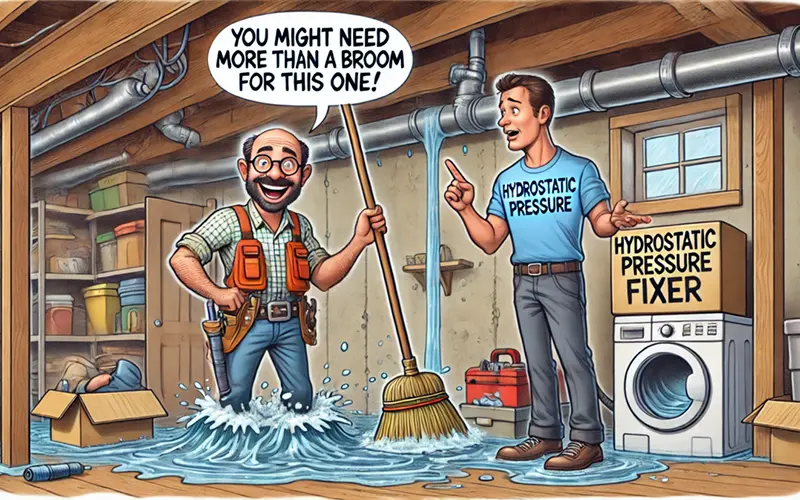Looking into how to fix hydrostatic pressure in basement walls? No worries! We can help you with that! Hydrostatic pressure happens when groundwater gathers around the foundation of your home and presses against the basement walls. This can result in water infiltration, damage, and mold growth, problems that are already common in Brooklyn and Long Island homes due to soil conditions and weather patterns that contribute to the problem.
That said, learning how to fix hydrostatic pressure in basement walls is essential for maintaining a safe home or business.
From the New York Area? Don’t Let Water Ruin Your Home – Trust Zavza Seal to Keep Your Basement Dry and Benefit from Our Expert Solutions Backed by a 30-Year Warranty!
Call (631) 980-1800 for a Free Assessment Now!
What is Hydrostatic Pressure?
Hydrostatic pressure is defined as force exerted on any surface by standing water. For your house, it means pressure exerted by the ground water on the basement walls or floor. If not immediately handled, this stress results in cracks, seepage of water, musty smells and growth of molds, and even serious structural damage. Early identification of these problems is necessary for preventing more damages from occurring and ensuring a healthy living environment.
Causes of Hydrostatic Pressure in Basement Walls
In order to confront the problem and avoid damage from hydrostatic pressure in basement walls, you should gain an understanding about what causes it. Malfunctioning drainage systems combined with poor drainage around a house’s foundation are key drivers for hydrostatic pressures building up, a problem that must be addressed diligently with these types of difficulties. Understanding the main causes of hydrostatic pressure will enable homeowners to take actions to safeguard their homes.
- Accumulation of Groundwater: Groundwater build-up around the foundation of your home is one of the primary causes of hydrostatic pressure. It can occur due to heavy rain or snow melt or because the water table in the area is too high.
- Poor Drainage Systems: Hydrostatic pressure problems are made worse by inefficient drainage systems. If your gutters, downspouts, or exterior drainage are not properly directing water away from your home, the excess water can pool around the foundation, increasing pressure on the basement walls.
- High Water Tables: In areas with elevated water tables, groundwater stands closer to the surface and therefore it exerts more pressure on basement walls. This happens mostly in low-lying places or those near bodies of water.
- Flooding: Basement wall hydrostatic pressures increase significantly when there are frequent or severe flooding events. The presence of floodwaters saturates the soil surrounding a structure’s foundation thereby raising pressures that would eventually result in possible seepages into its basement.
- Soil Conditions Around the Foundation: The type of soil that surrounds any house matters a lot. For instance, some soils like clay hold much more water hence exerting more hydrostatic pressures on basement walls. Proper grading and landscaping directs excess moisture away from structures thus preventing this issue.
Identification of Hydrostatic Pressure Issues
When you start observing some signs of hydrostatic pressure, it is advisable to take preventive measures that will help avoid massive destruction on your basement walls.
Here are some common signs of hydrostatic pressure to look for:
- Visible Cracks in Basement Walls: It is obvious that these cracks result from the water pressure underground.
- Water Seepage or Dampness: Consistent dampness or water getting into your cellar indicates a sign of hydrostatic pressure issues.
- Musty Odors and Mold Growth: Mold presence or that musty scent shows too much moisture typically due to high levels of hydrostatic pressure
How to Fix Hydrostatic Pressure in Basement Walls: Our Solutions Are Proven Effective!
For more severe cases of hydrostatic pressure in basement walls, you may need expert assistance. Zavza Seal has several state-of-the-art solutions:
- French Drain Installation: French drain installation is one best ways to direct groundwater away from your house relieving your home from such pressures.
- Basement Waterproofing: Basement waterproofing creates an additional barrier against seepage applying an extra layer of waterproof coating to prevent water penetration into homes.
- Sump Pump Installation: Basement sump pump installation can be used as an effective way of removing stagnated water keeping your basements dry.
Why Choose Zavza Seal for Hydrostatic Pressure Damage Repair?
In dealing with damages, leaks, or persistent dampness caused by hydrostatic pressure, Zavza Seal is leading the charge in waterproofing solutions in New York. Our expertise comes from years of experience and track record homes successfully protecting homes and businesses in Brooklyn and Long Island. Our professionals use current techniques and technology available ensuring a dry, safe home for years to come.
- Proven Expertise and Experience
- Advanced Waterproofing Techniques
- Customized Solutions for Every Home
- Exceptional Customer Service
- 30-Year Warranties on All Work
- Long-Term Protection and Peace of Mind
Check out our growing project portfolio here.
How to Prevent Hydrostatic Pressure
Preventing hydrostatic pressures are just as important as fixing existing ones.
The following are some steps that homeowners can take:
- Clean Gutters and Downspouts: Regularly clean away rubbish to allow water flow.
- Examine Exterior Drainage Systems: Guarantee that your foundation does not flood.
- Get Regular Inspections: Periodic consultations with waterproofing professionals will help in early diagnosis of problems before they become bigger challenges.
- Watch Basement Walls and Floors for Signs:: Cracks or slight wetness should be observed from the beginning stages.
Benefits of Professional Waterproofing Services
There are several long-term benefits to investing in professional waterproofing services:
- Improved Value for Property: Dry basements sell houses at higher prices than their counterparts which have either puddles on the floor or damp walls.
- Peace of Mind: Having your home defended against water damage enables you enjoy living comfortably.
- Savings on Expenses Incurred: This averts incidents such as repairs after a leak occurs giving rise to other costs once again in the future.
How to Fix Hydrostatic Pressure in Basement Walls: Final Thoughts
Addressing hydrostatic pressure in your basement walls is essential for maintaining the structural integrity and comfort of your home. By understanding the causes, identifying the signs, and taking both DIY and professional measures, you can protect your property from water damage.
Protect Your Basement and Get Free Expert Advice – Call Zavza Seal at (631) 980-1800 Now for Your Free Assessment!








